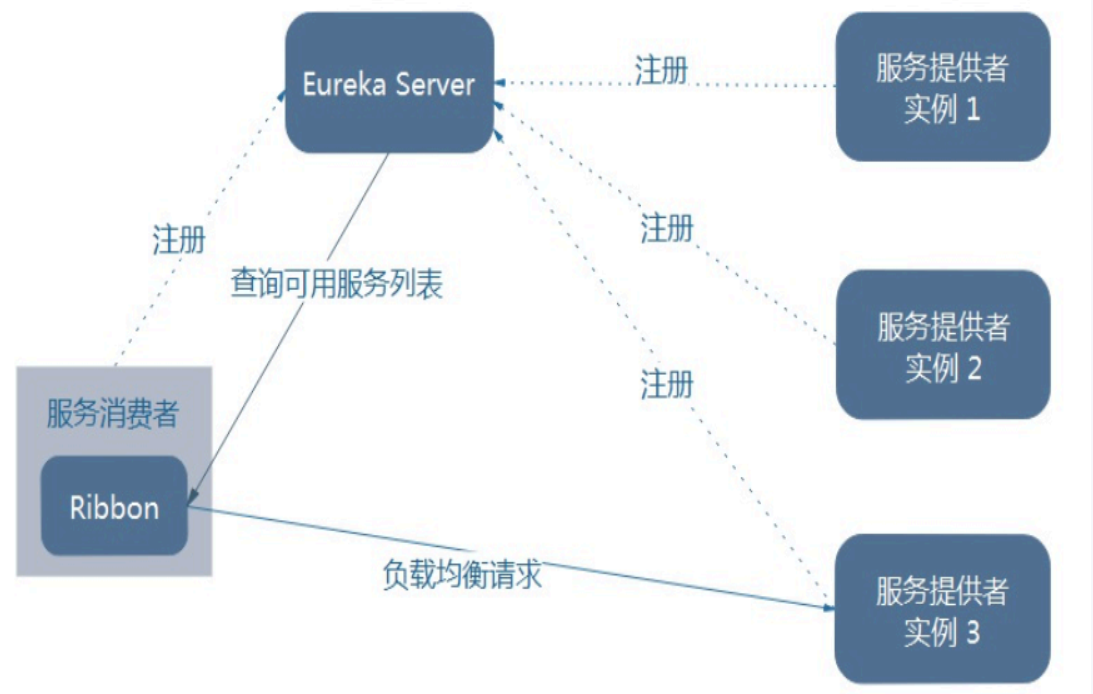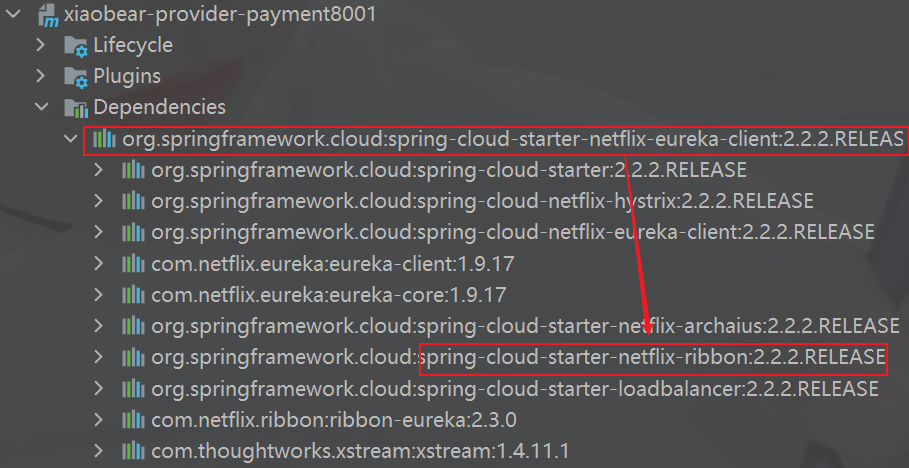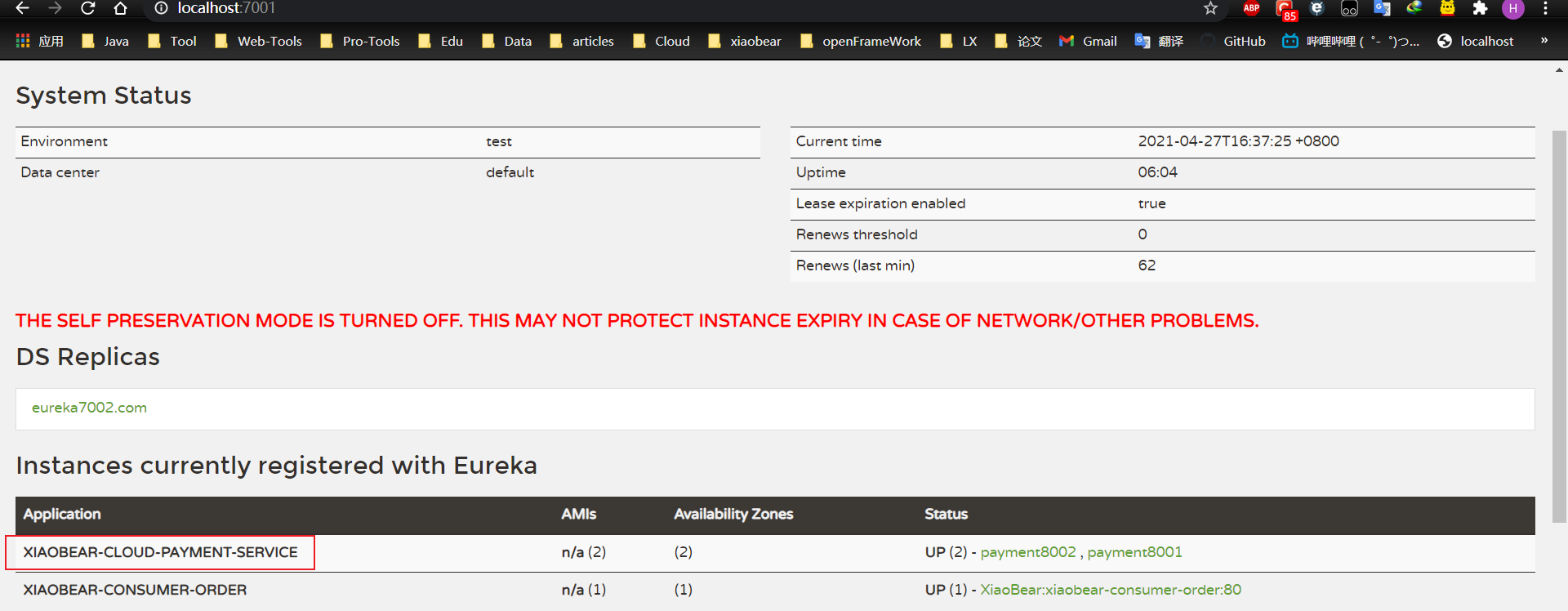gitee地址:https://gitee.com/javaxiaobear/spring-cloud_study.git
在线阅读地址:https://javaxiaobear.gitee.io/
1、概述
Spring Cloud Ribbon是基于Netflix Ribbon实现的一套客户端负载均衡的工具。
简单的说,Ribbon是Netflix发布的开源项目,主要功能是提供客户端的软件负载均衡算法和服务调用。Ribbon客户端组件提供一系列完善的配置项如连接超时,重试等。简单的说,就是在配置文件中列出Load Balancer(简称LB)后面所有的机器,Ribbon会自动的帮助你基于某种规则(如简单轮询,随机连接等)去连接这些机器。我们很容易使用Ribbon实现自定义的负载均衡算法
1、负载均衡分类
载均和分为硬件负载均衡和软件负载均衡:
硬件负载均衡:比如 F5、深信服、Array 等;
软件负载均衡:比如 Nginx、LVS、HAProxy 等;(是一个服务器实现的)
2、作用
1、LB负载均衡(Load Balance)是什么
简单的说就是将用户的请求平摊的分配到多个服务上,从而达到系统的HA(高可用)。
2、Ribbon本地负载均衡客户端 VS Nginx服务端负载均衡区别
Nginx是服务器负载均衡,客户端所有请求都会交给nginx,然后由nginx实现转发请求。即负载均衡是由服务端实现的。
Ribbon本地负载均衡,在调用微服务接口时候,会在注册中心上获取注册信息服务列表之后缓存到JVM本地,从而在本地实现RPC远程服务调用技术。
3、进程式LB与集中式LB
进程式LB
将LB逻辑集成到消费方,消费方从服务注册中心获知有哪些地址可用,然后自己再从这些地址中选择出一个合适的服务器。
Ribbon就属于进程内LB,它只是一个类库,集成于消费方进程,消费方通过它来获取到服务提供方的地址。
集中式LB
即在服务的消费方和提供方之间使用独立的LB设施(可以是硬件,如F5, 也可以是软件,如nginx), 由该设施负责把访问请求通过某种策略转发至服务的提供方;
3、总结
Ribbon就是负载均衡+RestTemplate调用
我们在Eureka就用到了负载均衡,8001和8002的访问
2、负载均衡演示

Ribbon在工作时分成两步
- 先选择 EurekaServer ,它优先选择在同一个区域内负载较少的server.
- 再根据用户指定的策略,在从server取到的服务注册列表中选择一个地址。
其中Ribbon提供了多种策略:比如轮询、随机和根据响应时间加权。
**总结:**Ribbon就是一个软负载均衡的客户端组件,他可以根据所需请求的客户端结合使用
那么,前面用到的Eureka的负载均衡是哪来的呢?
我们没有引入,猜测就是Eureka的客户端自带了ribbon,事实也是

1、RestTempalte的作用

官网地址:https://docs.spring.io/spring-framework/docs/5.2.2.RELEASE/javadoc-api/org/springframework/web/client/RestTemplate.html
1、getForObject/getForEntity方法
getForObject方法
返回对象为响应体中数据转化成的对象,基本上可以理解为Json
@GetMapping("/consumer/payment/get/{id}")
public CommonResult<Payment> getPayment(@PathVariable("id") Long id){
return restTemplate.getForObject(PAYMENT_SRV + "/payment/selectOne/"+id,CommonResult.class, id);
}
getForEntity方法
返回对象为ResponseEntity对象,包含了响应中的一些重要信息,比如响应头、响应状态码、响应体等
@GetMapping("/consumer/payment/getForEntity/{id}")
public CommonResult<Payment> getPayment2(@PathVariable("id") Long id){
ResponseEntity<CommonResult> entity = restTemplate.getForEntity(PAYMENT_SRV + "/payment/selectOne/" + id, CommonResult.class, id);
if (entity.getStatusCode().is2xxSuccessful()){
return entity.getBody();
}else {
return new CommonResult<>(400,"操作失败");
}
}
2、postForObject/postForEntity方法
1、postForObject方法
@GetMapping("/consumer/payment/insert")
public CommonResult<Payment> create(Payment payment){
return restTemplate.postForObject(PAYMENT_SRV+"/payment/insert",payment,CommonResult.class);
}
2、postForEntity方法
@GetMapping("/consumer/payment/postForEntity")
public CommonResult<Payment> create2(Payment payment){
ResponseEntity<CommonResult> postForEntity = restTemplate.postForEntity(PAYMENT_SRV + "/payment/insert", payment, CommonResult.class);
if (postForEntity.getStatusCode().is2xxSuccessful()){
return postForEntity.getBody();
}else {
return new CommonResult<>(400,"新增失败");
}
}
3、get/post方法
1、get方法
<T> T getForObject(String url, Class<T> responseType, Object... uriVariables);
<T> T getForObject(String url, Class<T> responseType, Map<String, ?> uriVariables);
<T> T getForObject(URI url, Class<T> responseType);
<T> ResponseEntity<T> getForEntity(String url, Class<T> responseType, Object... uriVariables);
<T> ResponseEntity<T> getForEntity(String url, Class<T> responseType, Map<String, ?> uriVariables);
<T> ResponseEntity<T> getForEntity(URI var1, Class<T> responseType);
2、post方法
<T> T postForObject(String url, @Nullable Object request, Class<T> responseType, Object... uriVariables);
<T> T postForObject(String url, @Nullable Object request, Class<T> responseType, Map<String, ?> uriVariables);
<T> T postForObject(URI url, @Nullable Object request, Class<T> responseType);
<T> ResponseEntity<T> postForEntity(String url, @Nullable Object request, Class<T> responseType, Object... uriVariables);
<T> ResponseEntity<T> postForEntity(String url, @Nullable Object request, Class<T> responseType, Map<String, ?> uriVariables);
<T> ResponseEntity<T> postForEntity(URI url, @Nullable Object request, Class<T> responseType);
3、核心组件 IRule
根据特定算法中从服务列表中选取一个要访问的服务

- RoundRobinRule:轮询
- RandomRule:随机
- RetryRule:先按照RoundRobinRule的 策略获取服务,如果服务获取失败,则在指定的时间内重试,获取可用的服务
- RestAvailableRule:先过滤调由于多次访问故障而处于断路器跳闸状态的服务,然后选择一个并发量最小的服务
- AvailabilityFulteringRule:先过滤调故障实例,再选择并发量最小的实例
- WeightedResponseTimeRule:对RoundRobinRule的扩展,响应速度越快的实例选择权重越大,越容易被选择
- ZoneAvoidanceRule:默认规则,复合判断server所在区域的性能和server的可用性选择服务器
1、如何进行替换
我们将对order80进行修改
配置注意
官方文档明确给出了警告:
这个自定义配置类不能放在@ComponentScan所扫描的当前包下以及子包下,
否则我们自定义的这个配置类就会被所有的Ribbon客户端所共享,达不到特殊化定制的目的了。
也就是启动类所在的包

新建规则类
@Configuration
public class XiaoBearRule {
//随机替换
@Bean
public IRule myRule(){
return new RandomRule();
}
}
主启动类加注解@RibbonClient
@SpringBootApplication
@EnableEurekaClient
@RibbonClient(name = "XIAOBEAR-CLOUD-PAYMENT-SERVICE",configuration= XiaoBearRule.class)
public class Order80Application {
public static void main(String[] args) {
SpringApplication.run(Order80Application.class,args);
}
}
name:是我们提供者的服务名称

configuration:新建的规则类
测试
http://localhost/consumer/payment/get/1
刷新会发现调用服务是随机的
4、Ribbon负载均衡算法
负载均衡算法:rest接口第几次请求数 % 服务器集群总数量 = 实际调用服务器位置下标 ,每次服务重启动后rest接口计数从1开始。
List<ServiceInstance> instances = discoveryClient.getInstances("XIAOBEAR-CLOUD-PAYMENT-SERVICE"); 如: List [0] instances = 127.0.0.1:8002 List [1] instances = 127.0.0.1:8001
8001+ 8002 组合成为集群,它们共计2台机器,集群总数为2, 按照轮询算法原理:
当总请求数为1时: 1 % 2 =1 对应下标位置为1 ,则获得服务地址为127.0.0.1:8001
当总请求数位2时: 2 % 2 =0 对应下标位置为0 ,则获得服务地址为127.0.0.1:8002
当总请求数位3时: 3 % 2 =1 对应下标位置为1 ,则获得服务地址为127.0.0.1:8001
当总请求数位4时: 4 % 2 =0 对应下标位置为0 ,则获得服务地址为127.0.0.1:8002
如此类推…
1、手写负载均衡
1、8001和8002的controller改造
@RestController
@RequestMapping("payment")
@Slf4j
public class PaymentController {
/**
* 服务对象
*/
@Resource
private PaymentService paymentService;
@Resource
private DiscoveryClient discoveryClient;
@Value("${server.port}")
private String serverPort;
/**
* 通过主键查询单条数据
*
* @param id 主键
* @return 单条数据
*/
@GetMapping("/selectOne/{id}")
public CommonResult selectOne(@PathVariable("id")Long id) {
Payment payment = paymentService.queryById(id);
if (null != payment){
return new CommonResult(200,"查询成功!serverPort:"+serverPort,payment);
}else {
return new CommonResult(404,"查询失败!serverPort"+serverPort,null);
}
}
@PostMapping("/insert")
public CommonResult createPayment(@RequestBody Payment payment){
Payment insert = paymentService.insert(payment);
log.info("插入成功!");
if (null != insert){
return new CommonResult(200,"插入数据库成功!serverPort:"+serverPort,insert);
}else {
return new CommonResult(500,"插入数据库失败!serverPort:"+serverPort,null);
}
}
@GetMapping("/discovery")
public Object discovery(){
List<String> services = discoveryClient.getServices();
for (String service : services) {
System.out.println(service);
}
List<ServiceInstance> instances = discoveryClient.getInstances("XIAOBEAR-CLOUD-PAYMENT-SERVICE");
for (ServiceInstance element : instances) {
System.out.println(element.getServiceId() + "\t" + element.getHost() + "\t" + element.getPort() + "\t"
+ element.getUri());
}
return this.discoveryClient;
}
@GetMapping(value = "/payment/lb")
public String getPaymentLB()
{
return serverPort;
}
}
2、80订单微服务改造
@Configuration
public class ApplicationContextConfig {
@Bean
// @LoadBalanced //使用@LoadBalanced注解赋予RestTemplate负载均衡的能力
public RestTemplate getRestTemplate(){
return new RestTemplate();
}
}
3、自定义接口与实现类
public interface XiaobearLoadBalanced {
ServiceInstance instances(List<ServiceInstance> serviceInstances);
}
@Component
public class XiaobearLoadBalancedImpl implements XiaobearLoadBalanced{
private AtomicInteger atomicInteger = new AtomicInteger(0);
/**
* 利用CAS和自旋锁 CAS比较并交换
* @return
*/
public int getServiceInstanceIndex(){
int current;
int index;
do {
current = atomicInteger.get();
index = current >= 2147483647 ? 0 : current + 1;
}while (!this.atomicInteger.compareAndSet(current,index));
System.out.println("*****next: "+index);
return index;
}
/**
*负载均衡算法:rest接口第几次请求数 % 服务器集群总数量 = 实际调用服务器位置下标 ,每次服务重启动后rest接口计数从1开始。
* @param serviceInstances
* @return
*/
@Override
public ServiceInstance instances(List<ServiceInstance> serviceInstances) {
int i = getServiceInstanceIndex() % serviceInstances.size();
return serviceInstances.get(i);
}
}
4、80的controller
@RestController
@Slf4j
public class OrderController {
private static final String PAYMENT_URL = "http://localhost:8001";
// 通过在eureka上注册过的微服务名称调用
public static final String PAYMENT_SRV = "http://XIAOBEAR-CLOUD-PAYMENT-SERVICE";
@Resource
private RestTemplate restTemplate;
@Resource
private DiscoveryClient discoveryClient;
@Resource
private XiaobearLoadBalanced xiaobearLoadBalanced;
public CommonResult<Payment> create(Payment payment){
return restTemplate.postForObject(PAYMENT_SRV+"/payment/insert",payment,CommonResult.class);
}
@GetMapping("/consumer/payment/postForEntity")
public CommonResult<Payment> create2(Payment payment){
ResponseEntity<CommonResult> postForEntity = restTemplate.postForEntity(PAYMENT_SRV + "/payment/insert", payment, CommonResult.class);
if (postForEntity.getStatusCode().is2xxSuccessful()){
return postForEntity.getBody();
}else {
return new CommonResult<>(400,"新增失败");
}
}
@GetMapping("/consumer/payment/get/{id}")
public CommonResult<Payment> getPayment(@PathVariable("id") Long id){
return restTemplate.getForObject(PAYMENT_SRV + "/payment/selectOne/"+id,CommonResult.class, id);
}
@GetMapping("/consumer/payment/getForEntity/{id}")
public CommonResult<Payment> getPayment2(@PathVariable("id") Long id){
ResponseEntity<CommonResult> entity = restTemplate.getForEntity(PAYMENT_SRV + "/payment/selectOne/" + id, CommonResult.class, id);
if (entity.getStatusCode().is2xxSuccessful()){
return entity.getBody();
}else {
return new CommonResult<>(400,"操作失败");
}
}
//测试自定义的负载均衡
@GetMapping("/consumer/payment/lb")
public String getServerPort(){
//获取服务
List<ServiceInstance> instances = discoveryClient.getInstances("XIAOBEAR-CLOUD-PAYMENT-SERVICE");
if(instances == null || instances.size()<=0) {
return null;
}
ServiceInstance serviceInstance = xiaobearLoadBalanced.instances(instances);
URI uri = serviceInstance.getUri();
return restTemplate.getForObject(uri+"/payment/payment/lb",String.class);
}
}
5、测试
http://localhost/consumer/payment/lb
可以发现8001和8002交替出现,重启之后,又从1开始






